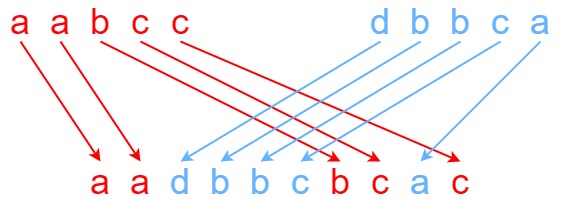Given strings s1, s2, and s3, find whether s3 is formed by an interleaving of s1 and s2.
An interleaving of two strings s and t is a configuration where s and t are divided into n and m
s = s1 + s2 + ... + snt = t1 + t2 + ... + tm|n - m| <= 1- The interleaving is
s1 + t1 + s2 + t2 + s3 + t3 + ...ort1 + s1 + t2 + s2 + t3 + s3 + ...
Note: a + b is the concatenation of strings a and b.
Example 1:
Input: s1 = "aabcc", s2 = "dbbca", s3 = "aadbbcbcac" Output: true Explanation: One way to obtain s3 is: Split s1 into s1 = "aa" + "bc" + "c", and s2 into s2 = "dbbc" + "a". Interleaving the two splits, we get "aa" + "dbbc" + "bc" + "a" + "c" = "aadbbcbcac". Since s3 can be obtained by interleaving s1 and s2, we return true.
Example 2:
Input: s1 = "aabcc", s2 = "dbbca", s3 = "aadbbbaccc" Output: false Explanation: Notice how it is impossible to interleave s2 with any other string to obtain s3.
Example 3:
Input: s1 = "", s2 = "", s3 = "" Output: true
Constraints:
0 <= s1.length, s2.length <= 1000 <= s3.length <= 200s1,s2, ands3consist of lowercase English letters.
Follow up: Could you solve it using only O(s2.length) additional memory space?
Companies: Amazon, Adobe, Google
Related Topics:
String, Dynamic Programming
// OJ: https://leetcode.com/problems/interleaving-string/
// Author: github.com/lzl124631x
// Time: O(2^(M+N))
// Space: O(MN)
class Solution {
int M, N;
vector<vector<int>> m;
int dfs(string &a, string &b, string &c, int i, int j) {
if (i == M && j == N) return 1;
if (m[i][j] != 0) return m[i][j];
int val = -1;
if (i < M && a[i] == c[i + j]) val = dfs(a, b, c, i + 1, j);
if (val != 1 && j < N && b[j] == c[i + j]) val = dfs(a, b, c, i, j + 1);
return m[i][j] = val;
}
public:
bool isInterleave(string s1, string s2, string s3) {
M = s1.size(), N = s2.size();
if (M + N != s3.size()) return false;
m.assign(M + 1, vector<int>(N + 1));
return dfs(s1, s2, s3, 0, 0) == 1;
}
};Let dp[i][j] be whether a[0..(i-1)] and b[0..(j-1)] can form c[0..(i+j-1)].
dp[i][j] = (i-1 >= 0 && a[i-1] == c[i+j-1] && dp[i-1][j])
|| (j-1 >= 0 && b[j-1] == c[i+j-1] && dp[i][j-1])
dp[0][0] = true
// OJ: https://leetcode.com/problems/interleaving-string/
// Author: github.com/lzl124631x
// Time: O(MN)
// Space: O(MN)
class Solution {
public:
bool isInterleave(string a, string b, string c) {
int M = a.size(), N = b.size();
if (c.size() != M + N) return false;
vector<vector<bool>> dp(M + 1, vector<bool>(N + 1));
dp[0][0] = true;
for (int i = 0; i <= M; ++i) {
for (int j = 0; j <= N; ++j) {
if (i == 0 && j == 0) continue;
dp[i][j] = (i >= 1 && a[i - 1] == c[i + j - 1] && dp[i - 1][j])
|| (j >= 1 && b[j - 1] == c[i + j - 1] && dp[i][j - 1]);
}
}
return dp[M][N];
}
};Since dp[i][j] is only dependent on dp[i-1][j] and dp[i][j-1], we can reduce the dp array from 2D to 1D.
// OJ: https://leetcode.com/problems/interleaving-string/
// Author: github.com/lzl124631x
// Time: O(MN)
// Space: O(N)
class Solution {
public:
bool isInterleave(string a, string b, string c) {
int M = a.size(), N = b.size();
if (c.size() != M + N) return false;
vector<bool> dp(N + 1);
dp[0] = true;
for (int i = 0; i <= M; ++i) {
for (int j = 0; j <= N; ++j) {
if (i == 0 && j == 0) continue;
dp[j] = (i >= 1 && a[i - 1] == c[i + j - 1] && dp[j]) || (j >= 1 && b[j - 1] == c[i + j - 1] && dp[j - 1]);
}
}
return dp[N];
}
};